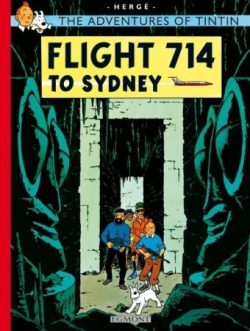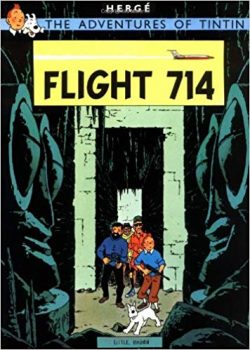

By Hergé, Bob De Moor, Roger Leloup and others, translated by Leslie Lonsdale-Cooper & Michael Turner (Egmont UK/Methuen/Little Brown Books)
ISBN: 978-1-40520-821-5 (HB) 978-0-31635-837-8 (Album PB)
Win’s Christmas Gift Recommendation: A Great British Tradition of Belgian Origin. Gotta Get ‘Em All… 10/10
Georges Prosper Remi, AKA Hergé, created an eternal masterpiece of graphic literature with his tales of a plucky boy reporter and entourage of iconic associates. Singly, and later with assistants including Edgar P. Jacobs, Bob de Moor, Roger Leloup and other supreme stylists of the Hergé Studio, he created 23 timeless yarns (initially serialised in instalments for a variety of newspaper periodicals) which have since grown beyond their pop culture roots to attain the status of High Art and international cultural icons.
On leaving school in 1925, Remi began working for conservative Catholic newspaper Le Vingtiéme Siécle where he fell under the influence of its Svengali-esque editor Abbot Norbert Wallez. A devoted boy scout, one year later the artist was producing his first strip series – The Adventures of Totor – for monthly Boy Scouts of Belgium magazine. By 1928 Remi was in charge of producing the contents of the newspaper’s weekly children’s supplement Le Petit Vingtiéme.
While he was illustrating The Adventures of Flup, N̩nesse, Poussette and Cochonette Рwritten by the staff sports reporter РWallez required his compliant creative cash-cow to concoct a new and contemporary adventure series. Perhaps a young reporter who roamed the world, doing good whilst displaying solid Catholic values and virtues?
The rest is history…
Some of that history is quite dark: During the Nazi Occupation of Belgium, Le Vingtiéme Siécle was closed down and Hergé was compelled to move his supremely popular strip to daily newspaper Le Soir (Brussels’ most prominent French-language periodical, and thus appropriated and controlled by the Nazis).
He diligently toiled on for the duration, but following Belgium’s liberation was accused of collaboration and even of being a Nazi sympathiser. It took the intervention of Belgian Resistance war-hero Raymond Leblanc to dispel the cloud over Hergé, which he did by simply vouching for the cartoonist through words and deeds.
Leblanc provided cash to create a new magazine – Le Journal de Tintin – which he published and managed. The anthology comic swiftly achieved a huge weekly circulation, allowing Remi and his studio team to remaster past tales: excising material dictated by the Fascist invaders to ideologically shade the wartime adventures. These modernising post-war exercises also generally improved and updated the great tales, just in time for Tintin to become a global phenomenon, both in books and as an early star of animated TV adventure.
With the war over and his reputation restored, Hergé entered the most successful period of his artistic career. He had mastered his storytelling craft, possessed a dedicated audience eager for his every effort and was finally able to say exactly what he wanted in his work, free from fear or censure, if not his personal demons and declining health…
The greatest sign of this was not substantially in the comics tales Рalthough Herg̩ continued to tinker with the form of his efforts Рbut rather in how long the gaps were between new exploits. The last romp had finished serialisation in September 1962 and been collected as an album in 1963. Vol 714 pour Sydney began its weekly run in Le Journal de Tintin #936 Р27th September 1966 Рand concluded in #997, cover-dated November 28th 1967. The inevitable book collection came in May 1968.
Flight 714 To Sydney appears to be a return to classic adventure, but conceals some ironic modernist twists, opening with our heroes hurriedly en route to Australia. During an intrigue-redolent stopover at Djakarta, Tintin, Captain Haddock and Professor Calculus are inveigled (almost duped) into joining unconventional and somewhat unpleasant aviation tycoon Laszlo Carreidas on his personal supersonic prototype. The petty-minded multi-millionaire obviously has some ulterior design but cannot be dissuaded.
However, due to the type of coincidence that plagues our heroes, that plane has been targeted by the villainous outlaw Rastapopoulos whose gang hijack the aircraft and land it on a desolate Pacific island. The former criminal mastermind has a crazy scheme to siphon off Carreidas’ fortune but has lost a lot of his old sinister efficiency…
After many ploys and countermoves between the opposing forces, and with danger a constant companion, the prisoners escape the villain’s clutches only to discover that the Island is volcanic and conceals a fantastic ancient secret that dwarfs the threat of mere death and penury before escalating to a spectacular climax no reader will ever forget…
Although full of Hergé’s trademark slapstick humour, there is also a sly undercurrent of self-examination that highlights the intrinsic futility of the criminals’ acts. As time has passed, the murderous human monsters have all been exposed as foolish, posturing and largely ineffectual.
Nevertheless, the yarn is primarily an extremely effective, suspenseful action thriller with science fiction roots as the author plays with the multifarious strands of international research then in vogue which led to Erich von Däniken’s Chariots of the Gods and other lesser known tracts of cod science.
Once more the supernormal plays a large part in proceedings – but not as a malign force – and this time science and rationality, not the supernatural, are the basis of the wonderment. Flight 714 To Sydney is slick, compelling and astoundingly engaging: a true epic escapade no fan of fun could fail to adore.
Flight 714 To Sydney: artwork © 1968 Casterman, Paris & Tournai. Text © 1968 Egmont UK Limited. All rights reserved.
